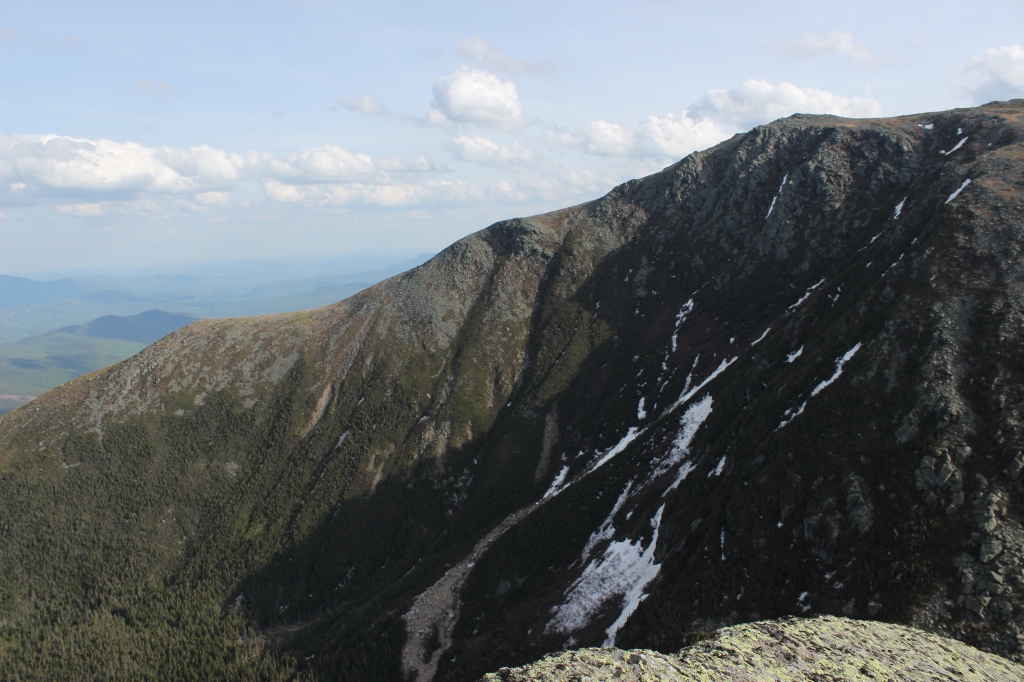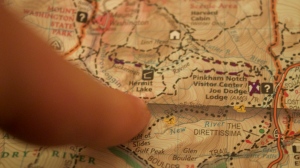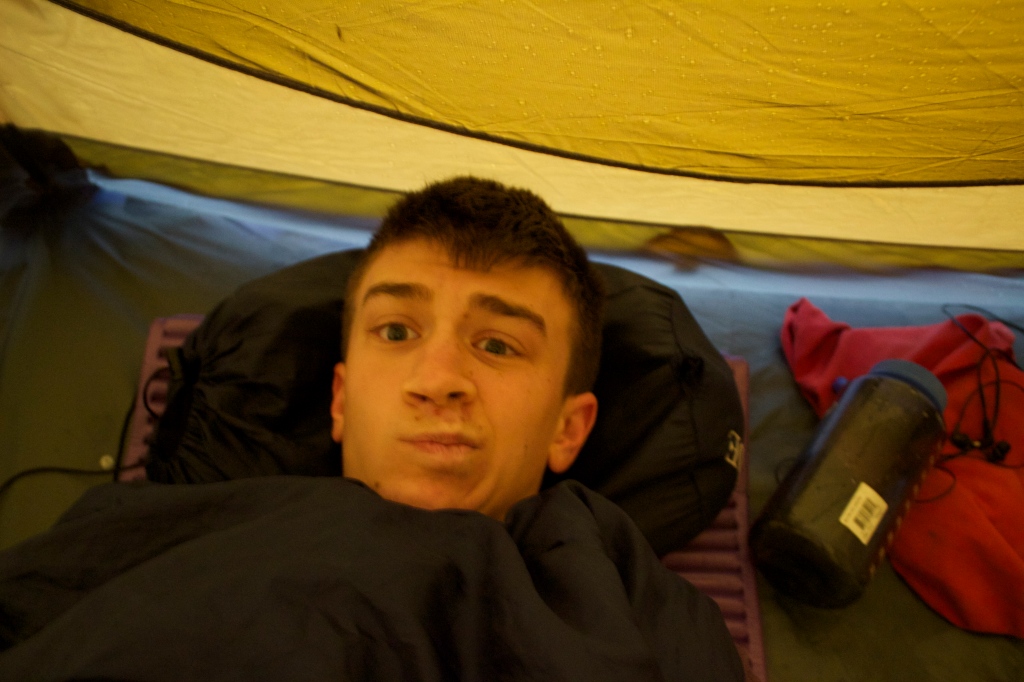I have been climbing and hiking for a little over a year now. My adventures have taken me across the northeast and I am ready for the future. I have been forced on more than one occasion to make the decision to turn around, to decide that I need to abort the summit. Thankfully up until a few days ago my choice to abort the summit has always been due to potential danger. I have been forced to decide to leave because I know that I will most likely get hurt. Up until my recent climb on Mt Washington I have never been in a life-threatening situation. Not to mention the fact that I only had my own life to worry about. Sadly though my track record changed on Wednesday. When poor conditions, an injury, as well as a precarious position forced me to “abort the summit.”
To explain why I was forced to make this choice I first need to describe the trip I was on. After a recent camping trip was aborted my friend Jon and I decided to climb Mt Washington. Jon and I had been on several hikes together however this was his first trip on a big mountain, and his first trip in the White Mountains. Knowing that my partner was comfortable with heights and in moderate physical condition we decided to climb Huntington Ravine. I have climbed multiple routes on Mt Washington Huntington Ravine has continuously eluded me. I have begun to believe that Mother Nature is against my conquering of the headwall. With high spirits I provided my friend with the proper gear, we filled my car with snacks and drove the three hundred miles to Pinkham Notch. Due to wonderful Massachusetts’s traffic conditions we arrived at 10:00pm. We responsibly filled out the hiking register discussed the conditions on Huntington Ravine and set out for Hermit Lake.
Our hike up to the camp went well until Mount Washington decided to dump a few thousand gallons of water on us. We set up our tent in the rain and overall we faired well we were not going to cry over wet socks. Preparing for the hike the next day we discussed the route and ate three servings of jambalaya each. We woke up around 10:00am well rested and ready to tackle the route. After notifying the caretaker of our plans and hiking to the headwall we admired the climb ahead of us. Climbing to the top of a large boulder the climbing of which resulted in me breaking one of my trusty trekking poles, we snapped various photos of the beautiful remote Huntington Ravine bowl. We also studied the distant headwall the most difficult portion of the hike.
We had been told repeatedly that the slab could not be down climbed. We went into this climb understanding that a rainstorm while climbing on the slab could well be fatal. However we had been told that it was going to rain at four o’clock we had two and a half hours to complete the forty-five minute climb. With high spirits we ate a few cliff bars and set out to conquer the boulder field.
For someone with very little climbing experience Jon did very well. I had to help him through a few difficult sections but he followed directions well. We booted our way through the field and quickly arrived at the slab. After a few climbers deviated to the left of the slab we followed, this however was a mistake. One of the climbers asked me to help him down after he found his route was too treacherous. After guiding the intrepid climber down I decided to follow the marked trail and began to climb up a crack.
After climbing for a few minutes I turned and Jon stated that he was stuck. My cheerful mood quickly shifted. The other climber asked if I needed help I told him we would be fine and he continued on with his hiking companion up the slab. I found a spot to rest and I tried to coax Jon towards a few decent footholds. However not to Jon’s own error he struggled to find the holds. I tried to keep him calm I never told him until later that I was terrified. He was stuck thirty feet up the slab above a cliff face, a fall would have been perilous. I knew Jon was scared and his fear was by no means aiding in his ability to find a proper route. The already touchy situation was only exacerbated when Jon said “is that rain?” The moment I felt a rain drop hit my arm our simple adventure became all too “real.” Jon asked me if I wanted to turn around I had to think quickly. I knew that I could quickly reach the top Jon would have taken longer. However I knew that a climb down would have been just as perilous. If we climb up in the rain it would be very easy to fall, if we climb down we faced the same fate. However I then thought about the extent of our possible injuries. If we slipped high on the slab the fall may well be fatal. However if we slipped down climbing we would most likely only fall around twenty to thirty feet. Although our injuries would have been severe I decided that I would take a broken femur over a cracked spine. Jon asked again what I wanted to do. Reluctantly I shouted, “We are going down.”
Jon was still stuck on the wall. In order to get to him I left my pack on the slab, chalked up, and climbed over to Jon. Guiding him slowly through a few tricky moves and an eventual controlled slide he arrived safely in the boulder field. I then climbed up the slab grabbed my pack and rejoined my friend in the boulder field. I shook Jon’s hand and told him he did well. With relaxed minds we began the climb through the boulder field. Our climb through the field would not be as easy as I had originally planned. The rain soaked the rocks turning the field of boulders into a dangerous passageway. With a certain level of fear we climbed through the field.
While traversing the boulder field Jon stated that he had an awful muscle cramp in his quads. I told Jon that he needs to dig deep and power through it. Although we were warm at the time no human being should spend a great deal of time soaked in forty-degree weather. At first Jon did very well powering through the cramp, sadly though the cramps soon enveloped all of his leg muscles. I told Jon that we need to get down to a dry rock so he can rest and wait for the cramps to pass. He was scared and in a great deal of pain, however he knew that he had no choice. With a great deal of coaxing he powered through the cramps.
We largely escaped with only a few bruises and a jammed wrist on my part. It was at the end of the field that any joy from this hike was removed from Jon’s mind. I was several feet ahead around the side of a boulder when I heard a loud scream followed by “help, help, help me!” With a certain expletive presented at my life I ran back expecting to see my friend laying on the ground with a broke leg or arm. However when I came around the corner I saw Jon standing dazed, wiping blood off his face, and flicking his teeth with his tongue. I asked him what happened. He said that fell face first into a boulder, he was very confused and I feared that he had a concussion. However he said that he only hit his jaw, I told him the cut to his lip was superficial the piece of tooth in his mouth was not on the other hand. He said that he could feel a crack I told him not to worry about it. Fearing that future pain would slow his progress I forced Jon to take a triple does of Advil hoping the drug would help to diminish the future pain. Jon turned to me and said, “Can we go home?” I turned to Jon and said, “of course we are going home.” I gave Jon my sole trekking pole and we started the long walk back to Hermit Lake. After a walk that seemed to go on forever and several tricky stream crossings we arrived at the caretakers hut. I explained the situation to him he did what he could, and provided Jon with an ice pack. The caretaker told Jon that he was very lucky. He said that the majority of the injuries in Huntington Ravine are very severe. Jon jokingly stated, “You should have seen the boulder.”
After checking in we packed up camp I tried to take some of the weight out of Jon’s pack and we began our descent towards Pinkham Notch. The hike down turned our knees into a fine powder happily though we covered the rough two and a half miles quickly and arrived at my car. With slightly broken spirits we signed the hikers register stating that we had left the mountain and began the long drive back to Connecticut. Jon was understandably frustrated, however he knew that in the grand scheme of things he was very lucky. He knew all too well that The White Mountains should never be trifled with. There are many people who have ventured into their grasp that would have been grateful to only lose a front tooth.
I have almost always hiked and climbed alone in my short career. When I make the choice whether or not to turn around I generally only need to consider my own life. If I had been alone I probably would have chosen to continue climbing, confident that I could have easily climbed up the wet slab. However for the first time I was forced to consider the fate of someone else, the fate of someone I have known for the majority of my life. I knew that if I had chosen to continue on and Jon had been hurt as a result of my decision I would likely never forgive myself. This fact is what forced me to make my reluctant call.
It is rare that a hike is ever “full on,” or “real.” In this case our journey was all too real. I am always prepared for many possible scenarios yet our well-prepared party still lost a bit more than our egos on Mt Washington. It amazes me how unprepared climbers are in both physical and mental fitness as well as equipment. You truly need to know what you are doing in the mountains in any season! I can only speculate that many parties in the same situation may have suffered a grimmer fate both in the past as well as the future. The moral of the story is that you need to be prepared to make the call to abort the summit. The mountain will always be there its life will never end. The lives of your friends as well as your own depend on your choice as to whether or not you want to continue with your climb. So when the time comes you need to be prepared to abort the summit.






















